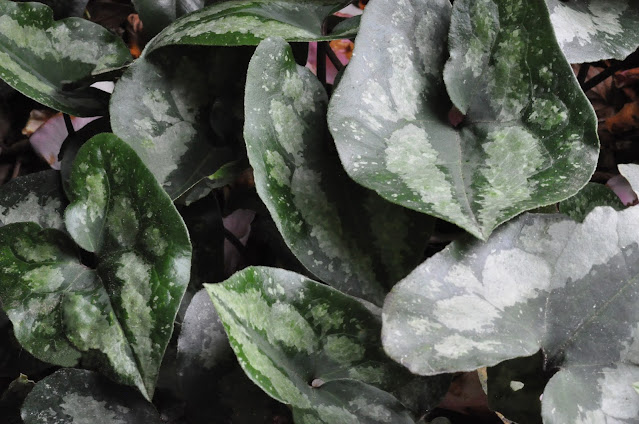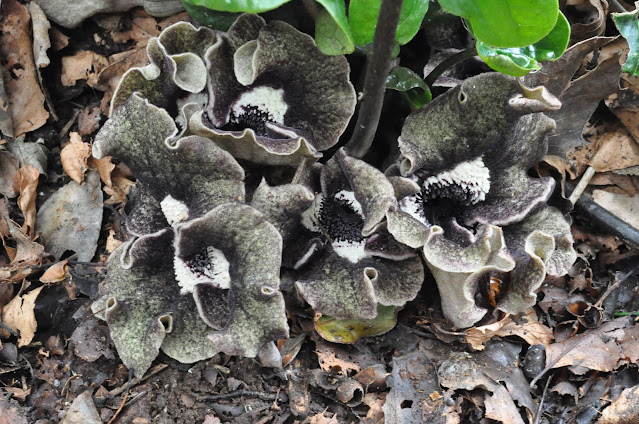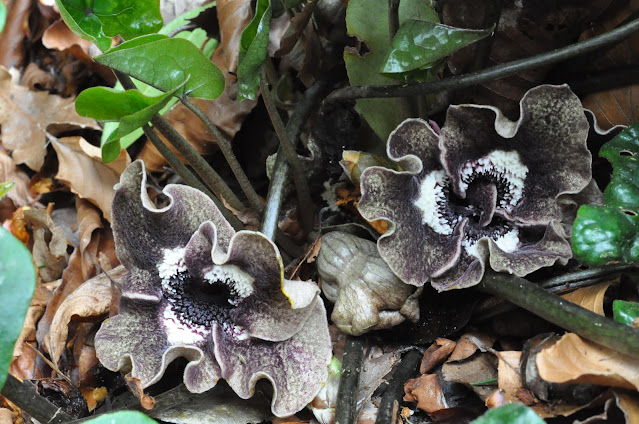Asarum.
Asarum's are an acquired taste, they are more about foliage than the flowers, as the flowers don't jump out at you, you will be looking at the leaves and then your eyes will pick out the flowers. I don't know if you are meant to cut back the foliage as you do for Helleborus or Epimedium's, I do worry it would take too much out of the plant as the leaves are large and fleshy. Asarum's make a wonderful ground cover for deep shade, they revel in deep leaf litter and spent Camellia flowers. My apologies if these Asarum's are incorrectly named, but this is what we imported them as and I have nowhere to compare them with in Australia, I have done my best with the internet.

Asarum delavayi an imported plant from Chen Yi in China, we received two forms of this plant named as
A. delavayi the leaves of one plant were dark green and covered in hairs the other plant has shiny foliage and no hairs at all. Flowers are the same on both plants.

As the leaves push through the earth they are folded in half and usually brown on their backs, and green on their inner side. I feed the Asarum's twice a year with pelletised chicken manure and potash.
Asarum maximum rare Chinese species, has a distinct smell of mushrooms and is endangered in the wild. Forms clumps of heart shaped leaves variegated or plain green, but mine are so badly eaten by slugs and snails I do not have a photo to show you of the foliage, the leaves are eaten as soon as they come through the soil. The flowers are quite large and have a distinct white edge to them fading to beige.
Asarum longorhizom E 11 this is the plant we imported from China named as A. longorhizom. There does not seem to be a flower on the internet that matches this flower, apologies for fuzzy photo as it has been planted in the garden and has not flowered for a long time so I have repotted it and I hope it will flower next year. Lovely long leaves, as I imagine that is where it received its name from. Hard to say if this Asarum like's deep leaf litter, like the rest of my Asarum's, but it tended to go backwards in the garden.
Asarum Kooyanum Double flowers Lynn's Rare Plants, Lynn says she has does not have any for sale at the moment, because they are so slow to multiply. The problem is the plants look large and ready for division with lots of foliage and when you look below the leaves, there is very little root growth making division difficult.
Asarum splendens E04 China import, flowers above leaves below.
Asarum splendens flowers above and foliage below. Plain green, hairy leaf below, on this form the flowers are almost double, folded and crowd in on each other. The hairs on the leaf make it feel course to touch but they are so fine you can barely see the them.
Asarum splendens non hairy leaf and new bud above and below.
Asarum splendens E04 green stems to the leaf axils and green leaves. To make that statement clearer, in some of the Asarums we imported the stems to the leaf axil are dark green almost black. As you can see from the previous photos the very dark stems on Asarum splendens.
Asarum delavayi E06 China import the old and new leaves, new leaves show a slight marbling but it disappears as it ages. I have struggled to name theses Asarums properly and as they flowered for the first time I recorded on their labels the differences between the stems, leaves hairy and non hairy and flowers as they were all different.
Asarum caudatum Winterwood Variegated. From Western North America from British Columbia to northern California. Growing at the feet of Hydrangea.
Asarum caudatum Winterwood Variegated the largest problem with this lovely small Asarum is it keeps reverting back to green leaf and loosing it variegation. Dan Hinkley in his book called "The Explorer's Garden" calls these "the woody vines of the genus Aristolochia, with their odd but charming pipes and the handsome ground covers the genus Asarum". Moist woodland plant covers a fairly large area, quite vigorous. Above and below.

Asarum hartwegii Rocky Mts seed sellers, found growing in Southwestern USA. Very similar to A. caudatum the flowers are very small on this variety and rarely seen as they hide below the leaves. They love shade and need very little sunlight, but love deep leaf litter and thrive.
Asarum hartwegii and Asarum splendends blending together to make a beautiful ground cover for shaded positions, in deep leaf litter and spent Camellia flower petals.

Asarum green flowers Lynn Mc Gough import, photo was taken as Lynn was leaving Olinda for NSW. We are uncertain of its name but we think it is one of the Japanese Asarum as Japan has quite a few and they are all interesting. Most of the Japanese forms have mottled leaves.

Saruma henryi.
Closely related to Asarum, in name as well as in form, the A is placed on the end and S at the beginning of the name, Saruma henryi is a lovely woodland plant getting up to 60cm with soft lemon, three petalled flowers. I had taken a pot of seedlings up to Antique Perennials after they were burnt out by bush fires and my friend Marg Taras commented "they look a bit weedy Viv". Perhaps they do seed in my glass house when allowed to flower before planting out, but in the garden it is hard to find a seedling, I haven't had one seedling after 6 years in the garden and you have to be on your toes to collect seed as it disappears quickly. It can be propagated by cuttings using new shoots with a base node, lightly wound so as just to remove the hair on the stems so that the stem is in contact with the hormone powder and stuck into perlite. From Hubei, Guizhou and Yunnan Provinces of China.

Just some of the seed coming in for our first seed exchange, don't forget to collect your seed your chance at first choices, for members only. Seed needs to be sent in by 10th of January.
Zoom meeting this coming Saturday October 31st with Alan speaking about Tasmania on the Overland Track and the plants Alan and his wife encountered in that area at 7.30pm contact Fermi for details and pass word Greg will be hosting meeting.
Harry Jan's plant explorer, tour leader and wonderful photographer has put together plants of China and sent to Di our president. Harry below photographing this dark almost black Primula at the Nottingham AGS conference. Harry was one of the speakers at the Nottingham AGS conference. Another Zoom meeting for our November 28th meeting at 7.30pm. Details will be sent out closer to the meeting.
AGS Victorian Group email address is; agsvicgroup@hotmail.com.au if you want to send us an email.


























No comments:
Post a Comment